 W
WAcrophyseter is a genus of extinct sperm whales that lived in the Late Miocene off the coast of Peru comprising two species: A. deinodon and A. robustus. It is part of a group of macroraptorial sperm whales which all shared several features for the purpose of hunting large prey, such as deeply-rooted and thick teeth. Acrophyseter measured 3.9–4.3 metres (13–14 ft), making it the smallest raptorial sperm whale. Because of its short pointed snout, and its strong curved front teeth, it probably fed on the large marine vertebrates of its time, such as seals and other whales.
 W
WAglaocetus is a genus of extinct mysticete known from the Miocene of Patagonia, the US Eastern Seaboard, Japan and the Low Countries. It was once considered a member of Cetotheriidae along with many other putative cetotheres, but was recently recognized as representing a distinct family from true Cetotheriidae.
 W
WAlbicetus is a genus of stem-sperm whales that lived during the Miocene Epoch, around 15 million years ago, and was discovered in Santa Barbara, California in 1909. It was categorized for decades as belonging to a group of extinct walruses erroneously thought to be sperm whales. It was named Albicetus, meaning "white whale", is a reference to the leviathan in Herman Melville's classic 1851 novel Moby-Dick.
 W
WAllodelphis is an extinct genus of whale belonging to Allodelphinidae found in marine deposits of the eastern North Pacific.
 W
WArchaebalaenoptera is a genus of extinct rorqual known from late Miocene to Pliocene-age marine deposits of the Netherlands, northern Italy, and Peru.
 W
WAulophyseter is an extinct genus of sperm whales from the Miocene formations of the west and east coasts of North America, as well as the Patagonian region of South America.
 W
WBrandtocetus is a genus of cetotheriid mysticete in the subfamily Cetotheriinae. The type and only species is Brandtocetus chongulek from the late Miocene (Tortonian) of the Kerch Peninsula in Crimea.
 W
WBrygmophyseter, known as the biting sperm whale, is an extinct genus of toothed whale in the sperm whale family with one species, B. shigensis. When it was first described in 1994, the species was placed in the genus Scaldicetus based on tooth morphology, but this was later revised in 1995. In 2006, it was classified into the genus Naganocetus, which is considered to be a junior synonym. The only known specimen, a nearly complete skeleton, was dated to be around 14–15 million years old. Brygmophyseter is thought to have been 7 meters (23 ft) long, and it probably had 11 or 12 teeth in the upper and lower jaws. Brygmophyseter is part of a group of macroraptorial sperm whales which tended to be apex predators using their large teeth to catch struggling prey such as whales. It had a spermaceti organ which was probably used for biosonar like in the modern sperm whale. The whale has made an appearance on The History Channel's TV series Jurassic Fight Club.
 W
WCetotheriopsis is a genus of extinct cetaceans of the family Cetotheriopsidae.
 W
WCetotherium is an extinct genus of baleen whales from the family Cetotheriidae.
 W
WChoneziphius is an extinct genus of ziphiidae cetaceans, with two species known from the Miocene: C. planirostris and C. leidyi.
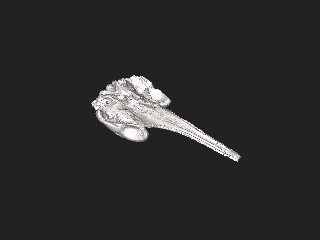 W
WDilophodelphis is an extinct genus of river dolphin from Early Miocene (Burdigalian) marine deposits in Oregon. The type species, Dilophodelphis fordycei, was named in 2017.
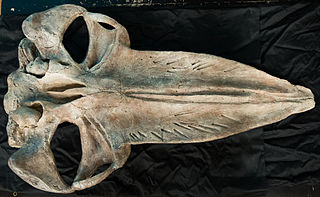 W
WDiorocetus is an extinct genus of baleen whale, belonging to the family Diorocetidae. Fossils are found in Miocene-aged marine strata in North America and Japan.
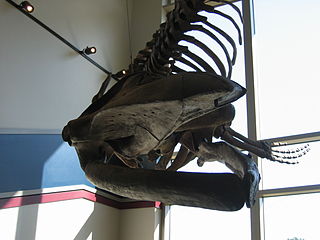 W
WEobalaenoptera is an extinct genus of baleen whale belonging to Balaenopteroidea.
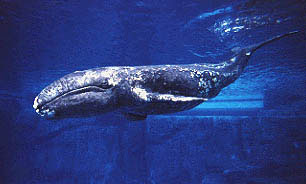 W
WEschrichtiidae or the gray whales is a family of baleen whale with a single extant species, the gray whale. The family, however, also includes three described fossil genera: Archaeschrichtius and Eschrichtioides from the Miocene and Pliocene of Italy respectively, and Gricetoides from the Pliocene of North Carolina. The names of the extant genus and the family honours Danish zoologist Daniel Eschricht.
 W
WEurhinodelphis is an extinct genus of Miocene cetacean. Its fossils have been found in Belgium, France, and Maryland.
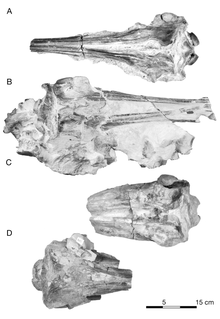 W
WGoedertius is an extinct genus of river dolphin from the early Miocene (Burdigalian) Nye Formation of Oregon.
 W
WIdiocetus is a genus of extinct cetaceans of the family Balaenidae.
 W
WIncakujira is an extinct genus of rorqual from the Late Miocene Pisco Formation in western Peru.
 W
WKentriodontidae is an extinct family of odontocete whales related to modern dolphins. The Kentriodontidae lived from the Oligocene to the Pliocene before going extinct.
 W
WLivyatan is an extinct genus of sperm whale containing one species: L. melvillei. The genus name was inspired by the biblical sea monster Leviathan, and the species name by Herman Melville, the author of the famous book Moby-Dick about a white bull sperm whale. It is mainly known from the Pisco Formation of Peru during the Tortonian stage of the Miocene epoch, about 9.9–8.9 million years ago (mya); however, isolated teeth from other locations such as Chile, Argentina, South Africa, and Australia implies that either it or a close relative survived into the Pliocene, around 5 mya, and was present throughout the Southern Hemisphere. It was a member of a group of hyper-predatory macroraptorial sperm whales and was likely an apex predator, preying on whales, seals, and so forth. Characteristic of raptorial sperm whales, Livyatan had functional, enamel-coated teeth on the upper and lower jaws, as well as several adaptations for hunting large prey.
 W
WMacrodelphinus is an extinct genus of primitive odontocete known from Late Oligocene (Chattian) marine deposits in California.
 W
WMacroraptorial sperm whales were highly predatory whales of the sperm whale family (Physeteroidea) of the Miocene epoch that hunted large marine mammals, including other whales, using their large teeth. Likewise, they were all likely the apex predator of their habitats, comparable to the modern day killer whale, and achieved great lengths, with one species–Livyatan–measuring about 13.5–17.5 metres (44–57 ft). The macroraptorial sperm whales–Albicetus, Acrophyseter, Brygmophyseter, Livyatan, Scaldicetus, and Zygophyseter–are an informal grouping of genera without a family designation. All species are known by at least a skull.
 W
WMithridatocetus is a genus of cetotheriid mysticete in the subfamily Cetotheriinae. Known specimens have been found in marine deposits in Crimea, Ukraine, and the Russian Caucasus.
 W
WNeosqualodon is an extinct genus of toothed cetacean, that lived in the modern Italy in the Middle Miocene (Langhian). Their fossils - mostly teeth and jaws - have been recovered in the Ragusa Formation of Sicilia, that are more robust and shorter than in the related genus Squalodon. Two species are known: N. assenzae and N. gemellaroi, that are distinguished by the shape of the teeth. Apparently this genus was endemic of the pre-Mediterranean sea of the Late Oligocene.
 W
WOdobenocetops is an extinct genus of small toothed whale known from Peru and Chile. Its fossils are found in Neogene-aged marine strata dating from the Tortonian to the Zanclean. It had two tusks, and, in some fossils, one tusk was longer than the other.
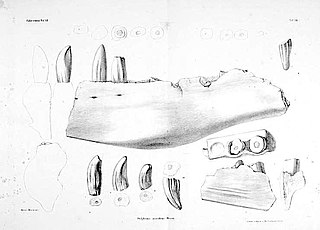 W
WOrcinus meyeri is a contentious fossil species of killer whale found in the Early Miocene deposits of southern Germany, known from two jaw fragments and 18 isolated teeth. It was originally described as Delphinus acutidens in 1859, but reclassified in 1873. Its validity is disputed, and it may be a synonymous with the ancient sperm whale Physeterula dubusi. It was found in the Alpine town of Stockach in the Molasse basin, which was a coastal area with strong tidal currents.
 W
WOrycteocetus is an extinct genus of sperm whale from the Miocene of the northern Atlantic Ocean.
 W
WParapontoporia is an extinct genus of dolphin that lived off the Californian coast from the Late Miocene until the genus' extinction during the Pliocene.It is related to the possibly extinct Baiji.
 W
WParietobalaena is an extinct genus of baleen whale, belonging to the family Pelocetidae. Fossils are found in Miocene-aged marine strata in North America, Europe, Australia and Japan.
 W
WPinocetus is an extinct genus of baleen whale, belonging to the family Cetotheriidae.
 W
WProsqualodon is an extinct genus of Early to Middle Miocene cetacean from Argentina, Australia, New Zealand and Venezuela.
 W
WSqualodon is an extinct genus of whales of the Oligocene and Miocene epochs, belonging to the family Squalodontidae. Named by Jean-Pierre Sylvestre de Grateloup in 1840, it was originally believed to be an iguanodontid dinosaur but has since been reclassified. The name Squalodon comes from Squalus, a genus of shark. As a result, its name means "shark tooth." Its closest modern relative is the South Asian river Dolphin.
 W
WTitanocetus is a genus of extinct cetaceans closely related to the family Cetotheriidae.
 W
WTranatocetus is an extinct genus of mysticete from the late Miocene (Tortonian) of Jutland, Denmark. The type and only species is Tranatocetus argillarius.
 W
WXiphiacetus is an extinct genus of cetacean known from the Miocene (early Burdigalian to late Tortonian, 20.43 to 7.246 million years ago of Europe and the U.S. East Coast.
 W
WZygophyseter varolai is an extinct sperm whale that lived during the Tortonian age of the Late Miocene 11.2 to 7.6 million years ago. It is known from a single specimen from the Pietra Leccese Formation in Italy. It was a member of a stem group of fossil macroraptorial sperm whales also including Brygmophyseter, Acrophyseter, and Livyatan. It probably grew to be around 6.5 to 7 meters in length and shared some characteristics with other raptorials, such as large teeth with tooth enamel that were functional in both the upper and lower jaws which the modern sperm whale lacks. It also had a beak, the ability to echolocate prey, and could have probably swum faster than the modern-day sperm whale which goes 4 kilometers per hour (2.5 mph). These were probably used in the capture of large prey, such as large fish, seals, and whales. In fact, its common name, the killer sperm whale, refers to its feeding habits that would have had a resemblance to the modern-day killer whale.